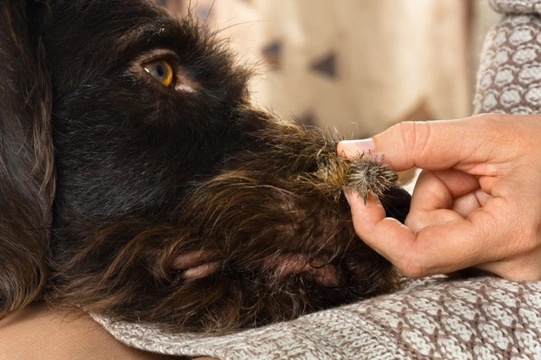
How to deal with burs, thistles, and other foliage in a dog’s fur
Summer weather means plenty of opportunities to explore the great outdoors with our dogs, but whether you live in a rural or urban area, you will also probably be all too aware that the warmer weather also means an explosion of plant growth in the parks and on common land, which can be a problem in various ways!
If you or your dog get hay fever or seasonal allergies, this can be an issue but even if that’s not the case, you’re probably more than used to coming back in from your summer walks to find that your dog seems to have brought a lot of the great outdoors in with them too, in the form of burs, thistles and sticky seeds and foliage that have hitched a ride on their fur.
Even if your dog has short, fine fur the chances are they still pick up burs and other foliage with spikes and hooks that work almost like Velcro when it comes to clinging on, but if you own a dog that both has thick feathered fur and that also likes to hare about in the bushes like the springer spaniel, this can soon turn into a big problem.
If your dog is forever coming back inside covered in burs and other forms of foliage that work their way into their fur to form tangles and you’ve got no way of avoiding walking in such areas, this article is designed to help.
Read on to learn how to deal with burs in dog fur, and the factors you need to bear in mind when it comes to removing thistles and seeds from your dog’s coat.
Why are burs and other foliage a problem for dogs?
If your dog has the type of fur that is dense, often curled or wavy, and that collects burs and other foliage, you can’t just leave it as is and wait for these things to work their own way out; they won’t! And they will cause potential problems for your dog if left alone too.
Burs and other types of sticky foliage will often work their way deep into your dog’s coat, and they cause tanging and matting that can form dense, tight patches that actually pull on the hairs over time and cause discomfort. This matting also traps dirt and bacteria and can make your dog’s skin sore, prone to infections, and more likely to host parasites.
It is also really hard to tackle and resolve coat issues that have got to this state, and generally they need to be fully clipped off to resolve the matter.
So, what can you do about burs and other things that catch in your dog’s coat?
Keep on top of things
First of all, removing burs from your dog’s coat is something you should do immediately, when you get back in from a walk (or otherwise spot them) each time, and they’re not something you should leave for a few days before addressing in one go.
It is much easier to keep on top of things and deal with burs after each walk than to try to sort out a far worse and more densely tangled mess later on!
Use conditioning sprays
Burs and other hitchhikers cling quite firmly to dog fur, and need to be picked out of the coat. But you can make it harder for them to catch on quite as strongly and make them easier to brush off by using a conditioning spray on your dog’s coat, which should be clean to start with.
Consider clipping your dog’s fur
If your dog has very dense fur, is very prone to getting burs in it or matts up easily, you might want to think about clipping their fur or at least trimming it down to reduce the problem and make it more manageable.
If your dog tends to get burs in particular problem areas like their chest fur, leg feathering, or between the back legs, these are often the areas where the fur is most dense and wavy, and just clipping, trimming or hand-stripping the fur to thin it out can help.
Get the right tools for the job
Picking the right grooming tools to remove burs will depend on what type of fur your dog has, and in many cases, your fingers will be best! However, thistles and thorns might make this unaviable, and in some cases, there are specific tools that can help to remove even small round burs that tangle up in the coat.
A few things to try include using a metal comb, conditioning spray, and potentially tools like a matt splitter, slicker brush, and other options that make it easier to part and separate the fur.
Make sure you cover the whole coat
It is really important to get right down to the base of your dog’s fur as this is where matting up can start, and also that you work right through difficult areas where the fur is often denser, like on the chest.
However, try and avoid pulling the fur, and keep sessions short, even if that means you need to keep tackling the same patch of fur a few times over the course of the day.



